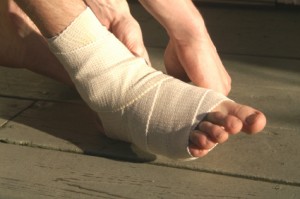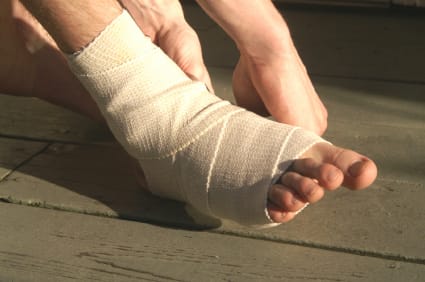 Whether you’re a moderate walker or a high intensity exerciser, there is no doubt that if you have been exercising long enough you have encountered some type of injury. Sometimes, it can be a mild injury like a slightly twisted ankle or a slight muscle strain just about anywhere, or occasionally it can be something more serious. Often, a proactive approach can cut your down time from exercise by days or weeks. But if you’ve had this experience, you know it can cause depressive feelings and often is the trigger for giving up something extremely vital to your health and wellbeing. As a trainer, I’ve seen too many people stop exercising altogether because of an injury.
Whether you’re a moderate walker or a high intensity exerciser, there is no doubt that if you have been exercising long enough you have encountered some type of injury. Sometimes, it can be a mild injury like a slightly twisted ankle or a slight muscle strain just about anywhere, or occasionally it can be something more serious. Often, a proactive approach can cut your down time from exercise by days or weeks. But if you’ve had this experience, you know it can cause depressive feelings and often is the trigger for giving up something extremely vital to your health and wellbeing. As a trainer, I’ve seen too many people stop exercising altogether because of an injury.
Soft tissue injuries include damage of muscles, ligaments, and tendons throughout the body. Common soft tissue injuries usually occur from a sprain, strain, a one off blow resulting in a contusion or overuse of a particular part of the body. Soft tissue injuries can result in pain, swelling, bruising or loss of function. If you have this type of injury, apply ice right away and put into play a procedure called RICE. RICE is an acronym for Rest, Ice, Compression and Elevation.
RICE can relieve pain, limit swelling and protect injured tissue – all of which help speed the healing process. Healing occurs as damaged tissue is replaced by collagen known as scar tissue. When scar tissue completes its repair on the injured area, one can go back to a full workout. Let’s take a closer look at how to implement the RICE procedure.
Rest: Rest is an integral part of the injury rehabilitation process for two reasons. First, rest protects the injured muscle, tendon, ligament or other soft tissue from further injury. Second, a rested limb has the energy necessary to heal itself most effectively. It should be noted that while resting the injured portion of your body is important, it doesn’t mean you need to stop working out all together. There are exercises you can do during the healing process to help keep yourself in shape.
Ice: You can use ice packs, bags of ice, or bags of frozen vegetables wrapped in a thin towel. Make sure the towel isn’t too thick so the treatment will be more effective. Cold brings short-term pain relief and reduces swelling by constricting the blood vessels and, in turn, blood-flow into the area. NEVER LEAVE ICE ON AN INJURY FOR MORE THAN 20 MINUTES. Long-term exposure to cold can cause damage to your skin. The best rule is to ice for 15 minutes, leave 15-20 minutes without ice and then repeat the treatment. After the ice is taken off the injury, vasodilatation occurs, meaning the blood vessels expand and bring in much-needed nutrients to the area.
Compression: Compressions is another way to curb swelling. This is important, as swelling impedes the healing process. Compression also reduces pain in some cases. The best way to compress an injury is to wrap it with an ace bandage. I advise wrapping an ice pack under the bandage when the injury first occurs. If you feel throbbing, rewrap the area with slightly less tension on the ace bandage.
Elevation: Elevating the injury is an additional way to bring down swelling. Keep the elevation at the same level as your heart.
If you have a slight twist or bruise, the odds are good that in the next day or two you will feel significant relief. However, if you suspect something more serious (extreme pain or malformation of the area), seek professional help from a doctor who has a good understanding of orthopedics.
People often assume that they have to stop exercising as soon as there is some type of injury. This is usually a big mistake. If you are injured, the injured area very well may need to be rested. But with some creativity we can come up with alternative methods of exercise instead of compromising our health entirely. An example might be something that happened to me many years ago. One Friday, after 65 minutes of running, I was doing a sprint and hit a pothole in the street, inverting my ankle. I had a severe sprain. I began icing and taking anti-inflammatory medication immediately but I had extreme swelling in the area and couldn’t put weight on it at all. I had to use crutches for a few days and it was a full five weeks before I could even begin lightly jogging again. Even walking was a big challenge. I could have decided to just to wait it out which would have cost my cardiovascular health and my muscle building. It would have also slowed down my metabolism over the five weeks. Instead, I used an exercise bike and kept my foot and ankle straight so I was able to work out my entire upper body. Recently, a client of mine developed a rare problem with the sheath in her foot. So instead of walking, she is using exercise videos at home for alternative aerobic exercise using exercises in the seated position and against the chair. THERE IS ALMOST ALWAYS A SOLUTION. One of the great things about exercise is that there are many ways to build certain muscle groups and many options to get a cardio workout.
Don’t let an injury turn into an excuse not to exercise. You will probably have to make some changes in your routine, but don’t give up on it altogether. And guess what? There is even research that tells us that people who can stay will heal faster!
So remember- most injuries from exercise are minor and using the RICE protocol mentioned above usually does the trick. But if it’s more serious than a minor soft tissue injury, seek proper medical attention. In most cases though, find an alternative way to work out that works for you.
Be careful coming back from injuries and err on the side of caution. Proceed slowly and carefully in your rehabilitiation.
Working your way through an injury without giving up exercise entirely will “add hours to your day, days to your year, and years to your life.”
Alan Freishtat is an A.C.E. CERTIFIED PERSONAL TRAINER and a BEHAVIORAL CHANGE and WELLNESS COACH with over 19 years of professional experience. Alan is the creator and director of the “10 Weeks to Health” program for weight loss. He is available for private coaching sessions, consultations, assessments and personalized workout programs both in his office and by telephone and skype. Alan also lectures and gives seminars and workshops. He can be reached at 02-651-8502 or 050-555-7175, or by email at alan@alanfitness.com Check out the his web site –www.alanfitness.com US Line: 516-568-5027.
The words of this author reflect his/her own opinions and do not necessarily represent the official position of the Orthodox Union.

